The NVIDIA GeForce GTX 780 Ti Review
by Ryan Smith on November 7, 2013 9:01 AM ESTOverclocking
Finally, let’s spend a bit of time looking at the overclocking prospects for the GTX 780 Ti. Although GTX 780 Ti is now the fastest GK110 part, based on what we've seen with GTX 780 and GTX Titan there should still be some headroom to play with. Meanwhile there will also be the matter of memory overclocking, as 7GHz GDDR5 on a 384-bit bus presents us with a new baseline that we haven't seen before.
| GeForce GTX 780 Ti Overclocking | ||||
| Stock | Overclocked | |||
| Core Clock | 876MHz | 1026MHz | ||
| Boost Clock | 928MHz | 1078MHz | ||
| Max Boost Clock | 1020MHz | 1169MHz | ||
| Memory Clock | 7GHz | 7.6GHz | ||
| Max Voltage | 1.187v | 1.187v | ||
Overall our overclock for the GTX 780 Ti is a bit on the low side compared to the other GTX 780 cards we’ve seen in the past, but not immensely so. With a GPU overclock of 150MHz, we’re able to push the base clock and maximum boost clocks ahead by 17% and 14% respectively, which should further extend NVIDIA’s performance lead by a similar amount.
Meanwhile the inability to unlock a higher boost bin through overvolting is somewhat disappointing, as this is the first time we’ve seen this happen. To be clear here GTX 780 Ti does support overvolting – our card offers up to another 75mV of voltage – however on closer examination our card doesn’t have a higher bin within reach; 75mV isn’t enough to reach the next validated bin. Apparently this is something that can happen with the way NVIDIA bins their chips and implements overvolting, though this the first time we’ve seen a card actually suffer from this. The end result is that it limits our ability to boost at the highest bins, as we’d normally have a bin or two unlocked to further increase the maximum boost clock.
As for memory overclocking, we were able to squeeze out a bit more out of our 7GHz GDDR5, pushing our memory clock 600MHz (9%) higher to 7.6GHz. Memory overclocking is always something of a roll of the dice, so it’s not clear here whether this is average or not for a GK110 setup with 7GHz GDDR5. Given the general drawbacks of a wider memory bus we wouldn’t be surprised if this was average, but at the same time in practice GK110 cards haven’t shown themselves to be as memory bandwidth limited as GK104 cards. So 9%, though a smaller gain than what we’ve seen on other cards, should still provide GTX 780 Ti with enough to keep the overclocked GPU well fed.
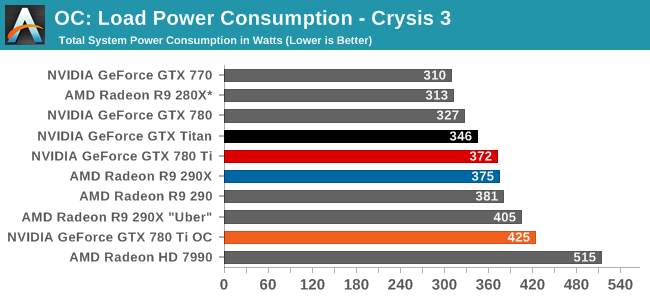
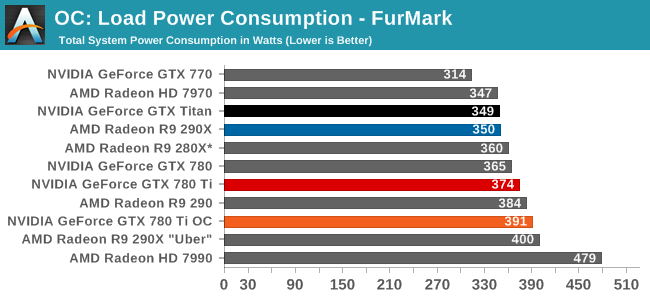
Starting as always with power, temperatures, and noise, we can see that overclocking GTX 780 Ti further increases its power consumption, and to roughly the same degree as what we’ve seen with GTX 780 and GTX Titan in the past. With a maximum TDP of just 106% (265W) the change isn’t so much that the card’s power limit has been significantly lifted – as indicated by FurMark – but rather raising the temperature limit virtually eliminates temperature throttling and as such allows the card to more frequently stay at its highest, most power hungry boost bins.
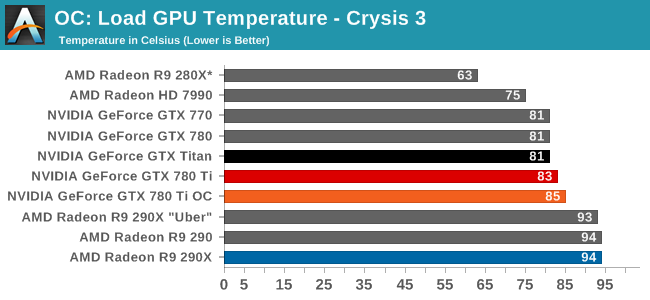

Despite the 95C temperature target we use for overclocking, the GTX 780 Ti finds its new equilibrium point at 85C. The fan will ramp up long before it allows us to get into the 90s.
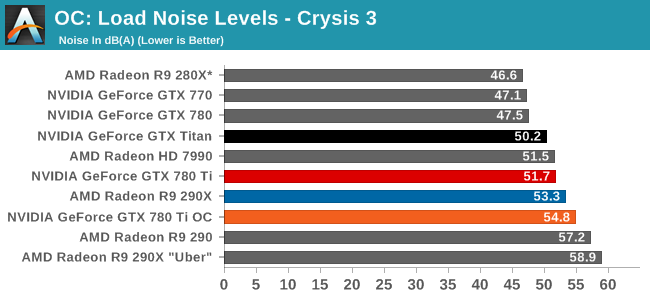
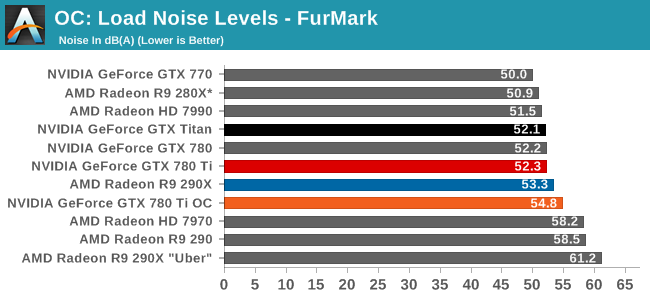
Given the power jump we saw with Crysis 3 the noise ramp up is surprisingly decent. A 3dB rise in noise is going to be noticeable, but even in these overclocked conditions it will avoid being an ear splitting change. To that end overclocking means we’re getting off of GK110’s standard noise efficiency curve just as it does for power, so the cost will almost always outpace the payoff on a relative basis.
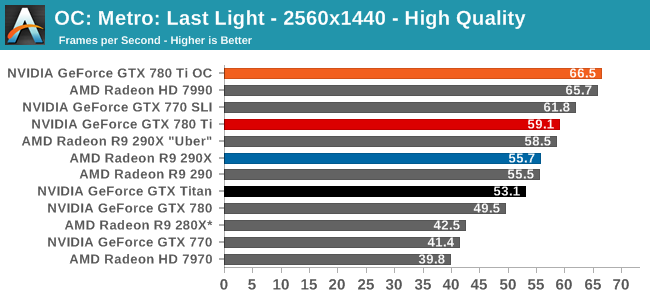
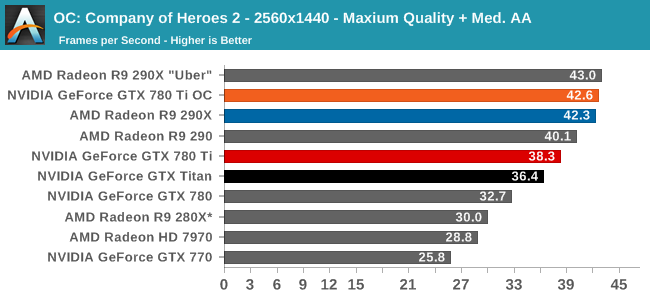
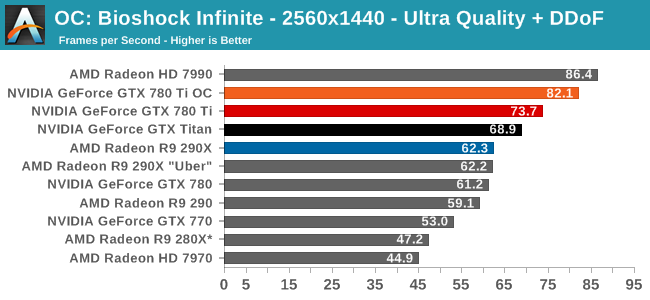
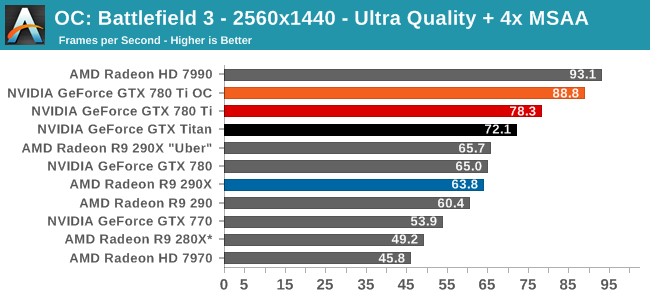
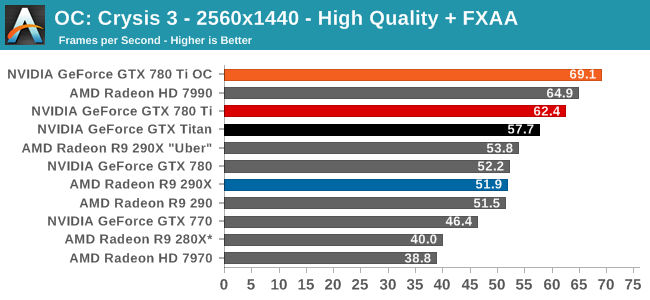
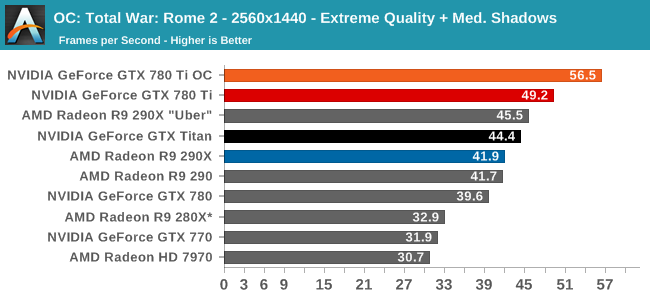
Finally, looking at gaming performance the the overall performance gains for overclocking are generally consistent. Between our 6 games we see a 10-14% performance increase, all in excess of the memory overclock and closely tracking the GPU overclock. GTX 780 Ti is already the fastest single-GPU card, so this only further improves its performance lead. But it does so while cutting into whatever is above it, be it the games where the stock 290X has a lead, or multi-GPU setups such as the 7990.










302 Comments
View All Comments
bigboxes - Thursday, November 7, 2013 - link
"Doesn't bode well." Just zip it.TheJian - Thursday, November 7, 2013 - link
https://www.youtube.com/watch?v=m1JOhT015wwFast forward to 8:35 or so...Got smashed, both OC'ed to the max. In Uber as anandtech even showed, it hits it's max all day. So 1ghz won't get more, and they run higher than that at linustechtips (both cards oced max they could get). Nowhere close in any benchmark they run. Don't forget you can clock the crap out of 780TI as already shown everywhere. If you're assuming a "Properly Cooled" ghz edition beats 780ti well we've only seen REF 780TI's so far too right? So what does a "Properly Cooled" 780ti do? They hit 1200-1300 stock fan. Will they hit 1300-1400 with an aftermarket fan? You won't catch it as it is without water and you'll need to be way over 1ghz to do it and pulling more watts no doubt.
What record are you giving? Assumptions and guesswork that goes against all current info from MANY sites. Check out all the sites I listed. That is what we call "for the record".
http://www.techpowerup.com/reviews/NVIDIA/GeForce_...
Only 1120/1175 (base/boost) and it's 30.8% faster than UBER 290x. Not even sure water would catch this and this is a WEAK OC compared to other sites like overclockers hitting 1291/1304. They can do this out of the box.
whiteswolf - Sunday, June 8, 2014 - link
to let you know the nvidea gtx 780 ti is walking and not breaking sweat. while the amdsare running think of it this way. if you over clock or make nvidea gtx 780 ti sprint it is said int can get a 19% to 20% boost in performence. and it only gets noise and sound of amds card.Da W - Thursday, November 7, 2013 - link
The only thing louder than a 290X is a Nvidia Fanboy.HisDivineOrder - Thursday, November 7, 2013 - link
Actually, I think the louder thing still is the sound of AMD fanboys coming into a review of a new nVidia halo product and crying about "nvidia fanboys." ;)OverclockedCeleron - Thursday, November 7, 2013 - link
Well, ask your colleague troll not to bring AMD trash talk into an Nvidia article. (See first comment to this article).bigboxes - Thursday, November 7, 2013 - link
Haha!Flunk - Thursday, November 7, 2013 - link
Sure, if you like to throw money away. Nvidia could seriously destroy AMD on this generation, but they're choosing not to compete by not pricing in line with performance.I personally think AMD has the edge when it comes to cost/unit because their chip is smaller, which is how they can price so much lower.
1Angelreloaded - Thursday, November 7, 2013 - link
See its about the feature sets as well that determine price, and of course support. The 289x should have been released with the 600 series not the end of the 700 series and at the edge of starting the 800 series in a few months with Maxwell.1Angelreloaded - Thursday, November 7, 2013 - link
edit "290x"